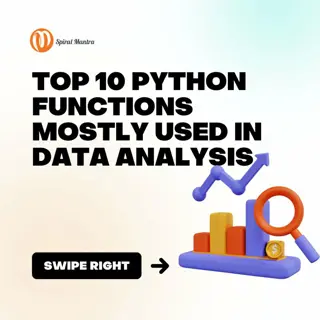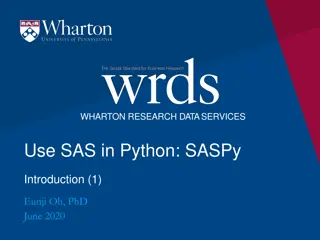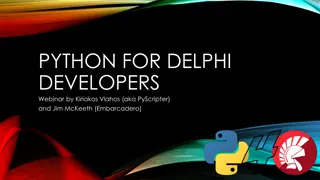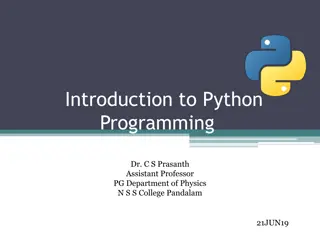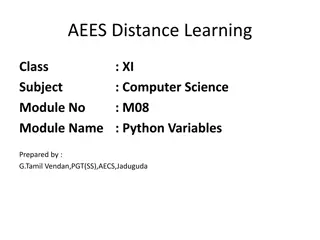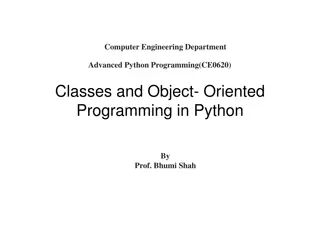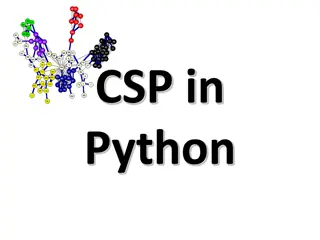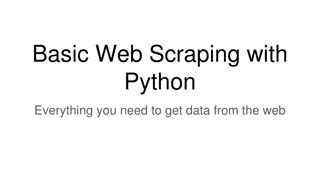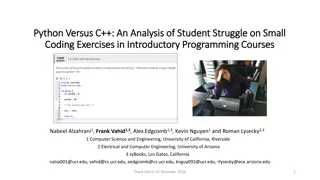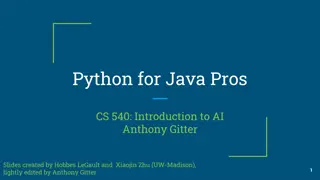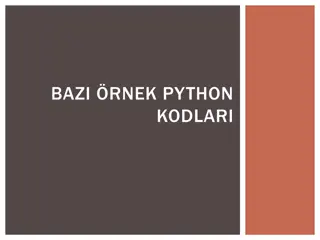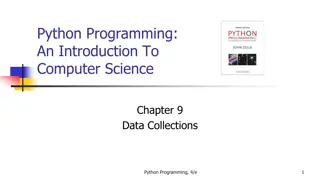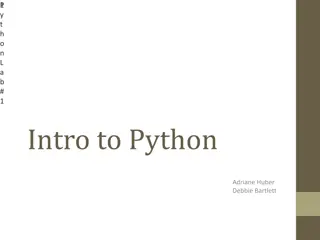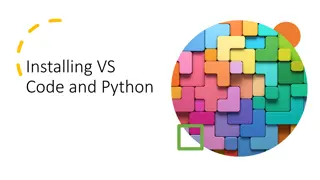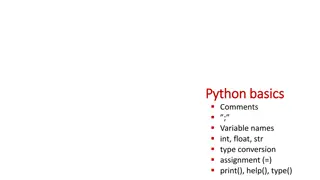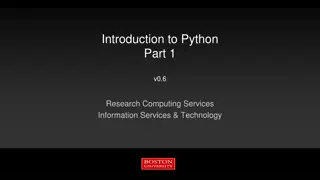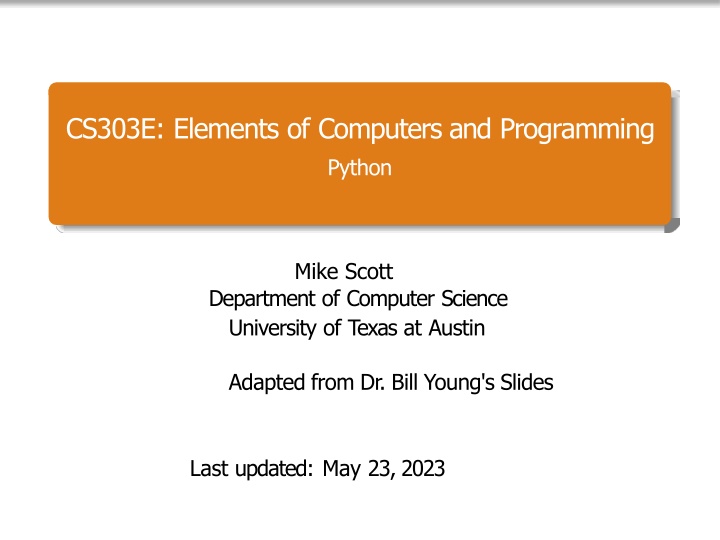
Understanding Python Programming Language
Python is a high-level, powerful, and versatile programming language developed by Guido van Rossum. It is known for its simplicity, clean syntax, and extensive library of functions, making it an excellent choice for both beginners and experienced programmers. Python's object-oriented nature allows for reusable software development, and its interpreted execution enables code translation and execution one statement at a time.
Download Presentation

Please find below an Image/Link to download the presentation.
The content on the website is provided AS IS for your information and personal use only. It may not be sold, licensed, or shared on other websites without obtaining consent from the author. If you encounter any issues during the download, it is possible that the publisher has removed the file from their server.
You are allowed to download the files provided on this website for personal or commercial use, subject to the condition that they are used lawfully. All files are the property of their respective owners.
The content on the website is provided AS IS for your information and personal use only. It may not be sold, licensed, or shared on other websites without obtaining consent from the author.
E N D
Presentation Transcript
CS303E: Elements of Computers and Programming Python Mike Scott Department of Computer Science University of Texas at Austin Adapted from Dr. Bill Young's Slides Last updated: May 23, 2023
Some Thoughts about Programming The only wayto learn a newprogramming language is bywriting programs in it. B. Kernighan and D. Ritchie "Computers are good at following instructions, but not at reading your mind." D. Knuth "Programming is not a spectator sport." - Bill Young Program: n. A magic spell cast over a computer allowing it to turn one s input into error messages. tr. v. Toengagein apastimesimilar to bangingone shead against a wall, but with fewer opportunities for reward. CS303E Slideset 1: 2 Python
What is Python? Python is a high-level programming language developed by Guido van Rossum in the Netherlands in the late 1980s. It was released in 1991. Python has twice received recognition as the language with the largest growth in popularity for the year (2007, 2010). It s named after the British comedy troupe Monty Python. CS303E Slideset 1: 3 Python
What is Python? Python is a simple but powerful scripting language. It has features that make it an excellent first programming language. Easy and intuitive mode of interacting with the system. Clean syntax that is concise. You can say/do a lot with few words. Design is compact. You can carry the most important language constructs in your head. There is a very powerful library of useful functions available. You can be productive quite quickly. You will be spending more time solving problems and writing code, and less time grappling with the idiosyncrasies of the language. CS303E Slideset 1: 4 Python
What is Python? Python is a general purpose programming language. That means you can use Python to write code for any programming tasks. Python was used to write code for: the Google search engine mission critical projects at NASA programs for exchanging financial transactions at the NY Stock Exchange the grading scripts for this class CS303E Slideset 1: 5 Python
What is Python? Python can be an object-oriented programming language. Object-oriented programming is a powerful approach to developing reusable software. More on that later! Python is interpreted, which means that Python code is translated and executed one statement at a time. This is different from other languages such as C which are compiled, the code is converted to machine code and then the program can be run after the compilation is finished. CS303E Slideset 1: 6 Python
The Interpreter Actually, Python is always translated into byte code, a lower level representation. The byte code is then interpreted by the Python Virtual Machine. CS303E Slideset 1: 7 Python
Getting Python To install Python on your personal computer / laptop, you can download it for free at: www.python.org/downloads There are two major versions: Python 2 and Python 3. Python 3 is newer and is not backward compatible with Python 2. Make sure you re running Python 3.8. It s available for Windows, Mac OS, Linux. If you have a Mac, it may already be pre-installed. It should already be available on most computers on campus. It comes with an editor and user interface called IDLE. I strongly recommend downloading and installing the PyCharm, Educational version, IDE. CS303E Slideset 1: 8 Python
A Simple Python Program: Interactive Mode This illustrates using Python in interactive modefrom the command line. Your command to start Python may be different. Here you see the prompt for the OS/command loop for the Python interpreter read, eval, print loop. CS303E Slideset 1: 9 Python
A Simple Python Program: Script Mode Here s the same program as I d be more likely to write it. Enter the following text using a text editor into a file called, say, MyFirstProgram.py. This is called script mode. In file my_first_program.py: CS303E Slideset 1: 10 Python
A Simple Python Program This submits the program in file my_first_program.py to the Python interpreter to execute. This is better, because you have a file containing your program and you can fix errors and resubmit without retyping a bunch of stuff. CS303E Slideset 1: 11 Python
Aside: About Print If you do a computation and want to display the result use the print function. You can print multiple values with one print statement: Notice that if you re computing an expression in interactive mode, it will display the value without an explicit print. Python will figure out the type of the value and print it appropriately. This is very handy when learning the basics of computations in Python. CS303E Slideset 1: 12 Python
Another aside: Binary Numbers, Base 2 Numbers The vast majority of computer systems use digital storage Some physical phenomena that is interpreted to be a 0 or 1 abstraction, pretending something is different, simpler, than it really is also known as binary representations 1 bit -> 1 binary digit, a 0 or a 1 1 byte -> 8 bits binary numbers, base 2 numbers CS303E Slideset 1: 13 Python
Base 2 Numbers 537210 = (5 * 1,000) + (3 * 100) + (7 * 10) + (2 * 1) = (5 * 103)+ (3 * 102)+ (7 * 101)+ (2 * 100) Why do we use base 10? 10 fingers? Choice of base is somewhat arbitrary In computing we also use base 2, base 8, and base 16 depending on the situation In base 10, 10 digits, 0 - 9 In base 2, 2 digits, 0 and 1 CS303E Slideset 1: 14 Python
Base 2 Numbers 10110112 = (1 * 64) + (0 * 32) + (1 * 16) + (1 * 8) + (0 * 4) + (1 * 2) + (1 * 1) = 91 = (1 * 26) + (0 * 25) + (1 * 24) + (1 * 23) + (0 * 22) + (1 * 21) + (1 * 20) = 91 Negative numbers and real numbers are typically stored in a non-obvious way If the computer systems only stores 0s and 1s how do we get digital images, characters, colors, sound, Encoding CS303E Slideset 1: 15 Python
Encoding Encoding is a system or standard that dictates what "thing" is representing by what number Example ASCII or UTF-8 This number represents this character First 128 numbers of ASCII and UTF-8 same 32 -> space character 65 -> capital A 97 -> lower case a 48 -> digit 0 CS303E Slideset 1: 16 Python
Computer Memory Recall, 1 bit -> a single 0 or 1 1 byte = 8 bits A typical laptop or desktop circa 2023 has 4 to 32 Gigabytes of RAM, also known as main memory. 1 Gigabyte -> 1 billion bytes The programs that are running store their instructions and data (typically) in the RAM have 100s of Gigabytes up to several Terabytes (trillions of bytes) in secondary storage. Long term storage of data, files Typically spinning disks or solid state drives. CS303E Slideset 1: 17 Python
The Framework of a Simple Python Program Define your program in file Filename.py: Defining a function called main. def main ( ) : Python Python Python statement . . . Python statement Python statement Python statement statement statement These are the instructions that make up your program. Indent all of them the same amount (usually 4 spaces). This says to execute the function main. main ( ) To run it: This submits your program in file_name.py to the Python interpreter. > python file_name.py CS303E Slideset 1: 18 Python
Aside: Running Python From a File Typically, if your program is in file hello.py, you can run your program by typing at the command line: > python hello.py You can also create a standalonescript. On a Unix / Linux machine you can create a script called hello.py containing the first line below (assuming that s where your Python implementation lives): #! / l usr / bi n/ pyt hon3 # The line above may vary based on your system pr i nt('Hello World!') CS303E Slideset 1: 19 Python
Program Documentation Documentation refers to comments included within a source code file that explain what the code does. Include a file header: a summary at the beginning of each file explaining what the file contains, what the code does, and what key feature or techniques appear. You shall always include your name, email, grader, and a brief description of the program. # File: <NAME OF FILE> # Description: <A DESCRIPTION OF YOUR PROGRAM> # Assignment Number: <Assignment Number, 1 - 13> # # Name: <YOUR NAME> # EID: <YOUR EID> # Email: <YOUR EMAIL> # Grader: <YOUR GRADER'S NAME Carolyn OR Emma or Ahmad> # # On my honor, <YOUR NAME>, this programming assignment is my own work # and I have not provided this code to any other student. CS303E Slideset 1: 20 Python
Program Documentation Comments shall also be interspersed in your code: Before each function or class definition (i.e., program subdivision); Before each major code block that performs a significant task; Before or next to any line of code that may be hard to understand. sum = 0 # sum t he i nt eger s [ st ar t f or i i n r ange( sum += i . . . end] st art , end + 1) : CS303E Slideset 1: 21 Python
Dont Over Comment Comments are useful so that you and others can understand your code. Useless comments just clutter things up: # assign 1 to x # assign 2 to y x = 1 y = 2 CS303E Slideset 1: 22 Python
Programming Style Every language has its own unique syntax and style. This is a C program. #i ncl ude <st di o. h> / * print table of Fahrenheit [ C = 5/ 9( F- 32) ] 300 * / to Celsius = 0, 20, f or f ahr . . . , m ai n( ) { i nt i nt Good programmers follow certain conventionsto make programs clear and easy to read, understand, debug, and maintain. We have conventions in 303e. Check the assignment page. f ahr , l ow er , cel si us ; upper , st ep; lower = 0; upper = 300; step = 20; fahr = lower; w hi l e ( f ahr cel si us = 5 * ( f ahr - 32) pr i nt f ( " % d\t % d\n" , f ahr = f ahr } / * low limit of table * / / * high limit / * step size of table * / * / <= upper ) { / 9; f ahr , cel si us ) ; + st ep; } CS303E Slideset 1: 23 Python
Programming Style Some important Python programming conventions: Follow variable and function naming conventions. Use meaningful variable/function names. Document your code effectively. Each level indented the same (4 spaces). Use blank lines to separate segments of code inside functions. 2 blank lines before the first line of function (the function header) and after the last line of code of the function We ll learn more elements of style as we go. Check the assignments page for more details. CS303E Slideset 1: 24 Python
Errors: Syntax Remember: Program: n. A magic spell cast over a computer allowing it to turn one s input into error messages. We will encounter three types of errorswhendeveloping our Python program. syntax errors: these areill-formed Python and caught bythe interpreter prior to executing your code. >>> 3 = x Fi l e " <st di n>" , Synt axEr r or : l i t er al These are typically the easiest to find and fix. l i ne 1 assi gn t o can t CS303E Slideset 1: 25 Python
Errors: Runtime runtime errors: you try something illegal while your code is executing >>> x = 0 >>> y = 3 >>> y / x Tr aceback ( m ost Fi l e " <st di n>" , Zer oDi vi si onEr r or : r ecent l i ne 1, di vi si on by zer o cal l l ast ) : i n <m odul e > CS303E Slideset 1: 26 Python
Almost Certainly Its Our Fault! At some point we all say: My program is obviously right. The interpreter / Python must be incorrect / flaky / and it hates me. "As soon as we started programming, we found out to our surprise that it wasn't as easy to get programs right as we had thought. Debugging had to be discovered. I can remember the exact instant when I realized that a large part of my life from then on was going to be spent in finding mistakes in my own programs." -Sir Maurice V Wilkes CS303E Slideset 1: 27 Python
Errors: Logic logic errors: Calculate 6! (6 * 5 * 4 * 3 * 2 * 1) your program runs but returns an incorrect result. >>> prod = 0 >>> for x in r a n g e ( 1 , 6 ) : . . . prod *= x >>> pr i nt ( pr od) 0 This program is syntactically fine and runs without error. But it probably doesn t do what the programmer intended; it always returns 0 no matter the values in range. How would you fix it? Logic errors are typically the hardest errors to find and fix. CS303E Slideset 1: 28 Python
Try It! The only wayto learn a newprogramming language is bywriting programs in it. B. Kernighan and D. Ritchie Python is wonderfully accessible. If you wonder whether something works or is legal, just try it out. Programming is not a spectator sport! Write programs! Do exercises! CS303E Slideset 1: 29 Python

